Management Theories and HR Practices in Organizations Report
VerifiedAdded on 2020/02/05
|12
|4366
|68
Report
AI Summary
This report provides a comprehensive analysis of management theories and their application within organizations. It begins with an introduction highlighting the importance of management theories in achieving organizational goals. The report then delves into three key motivational theories: Maslow's hierarchy of needs, Herzberg's two-factor theory, and McGregor's XY theory, evaluating their impact on management practices, situations, and issues. It examines how these theories influence employee motivation and organizational operations. The report further assesses the contribution of management theories to organizational practices, focusing on the contingency theory and its role in decision-making. Finally, it explores the analysis of internal functions and HR practices, emphasizing their significance in ensuring organizational progress. The report utilizes various sources to support its arguments and provides a critical evaluation of the discussed concepts.
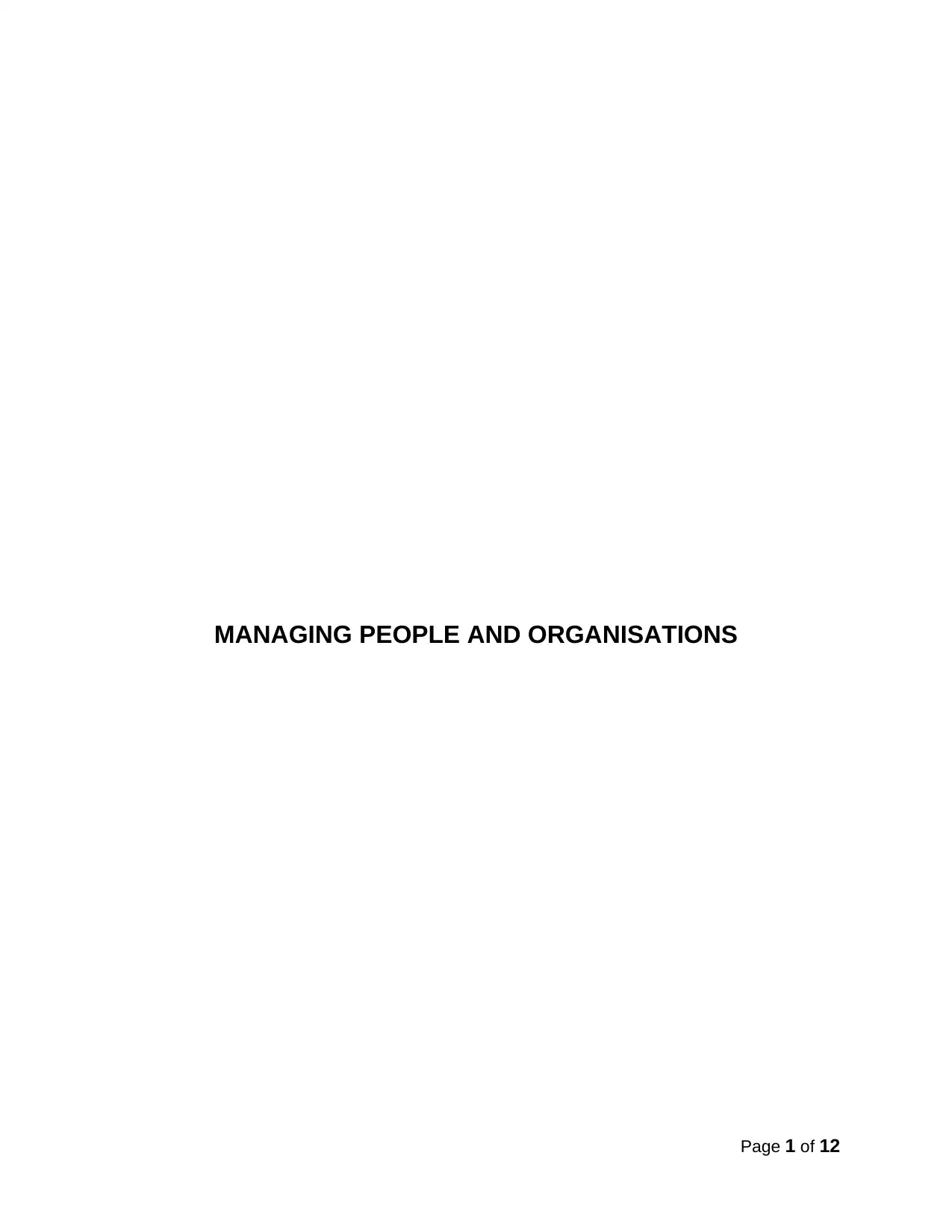
MANAGING PEOPLE AND ORGANISATIONS
Page 1 of 12
Page 1 of 12
Secure Best Marks with AI Grader
Need help grading? Try our AI Grader for instant feedback on your assignments.
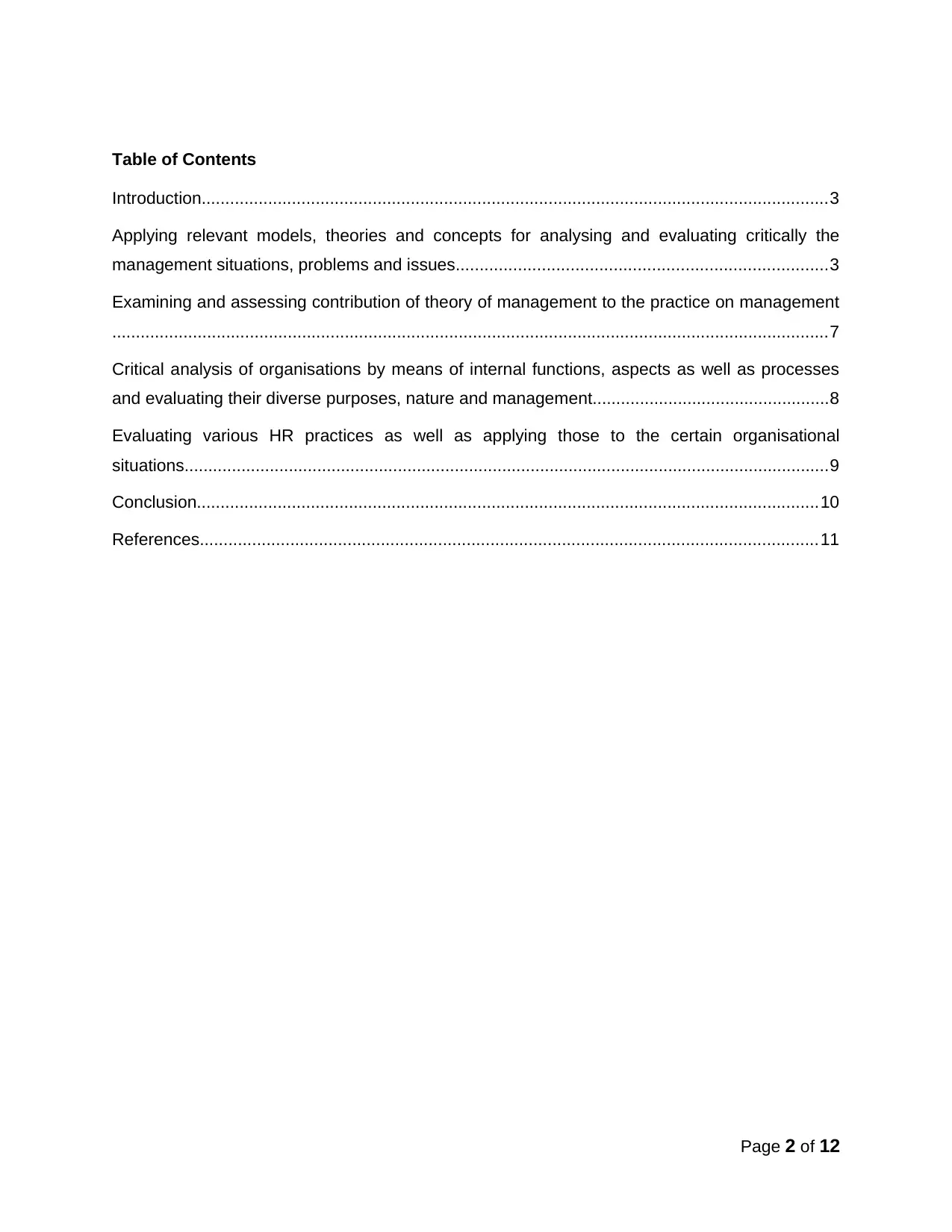
Table of Contents
Introduction....................................................................................................................................3
Applying relevant models, theories and concepts for analysing and evaluating critically the
management situations, problems and issues..............................................................................3
Examining and assessing contribution of theory of management to the practice on management
.......................................................................................................................................................7
Critical analysis of organisations by means of internal functions, aspects as well as processes
and evaluating their diverse purposes, nature and management..................................................8
Evaluating various HR practices as well as applying those to the certain organisational
situations........................................................................................................................................9
Conclusion...................................................................................................................................10
References..................................................................................................................................11
Page 2 of 12
Introduction....................................................................................................................................3
Applying relevant models, theories and concepts for analysing and evaluating critically the
management situations, problems and issues..............................................................................3
Examining and assessing contribution of theory of management to the practice on management
.......................................................................................................................................................7
Critical analysis of organisations by means of internal functions, aspects as well as processes
and evaluating their diverse purposes, nature and management..................................................8
Evaluating various HR practices as well as applying those to the certain organisational
situations........................................................................................................................................9
Conclusion...................................................................................................................................10
References..................................................................................................................................11
Page 2 of 12
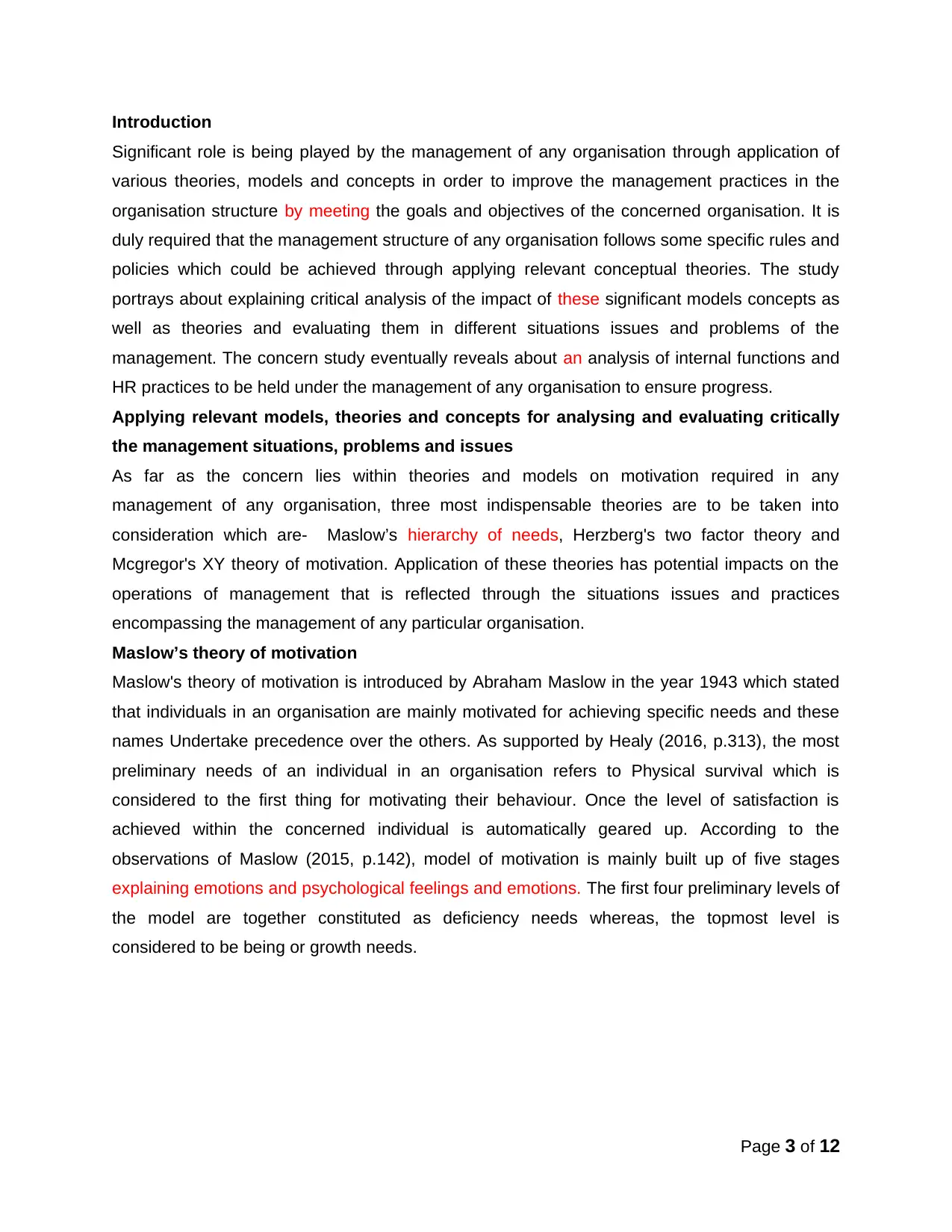
Introduction
Significant role is being played by the management of any organisation through application of
various theories, models and concepts in order to improve the management practices in the
organisation structure by meeting the goals and objectives of the concerned organisation. It is
duly required that the management structure of any organisation follows some specific rules and
policies which could be achieved through applying relevant conceptual theories. The study
portrays about explaining critical analysis of the impact of these significant models concepts as
well as theories and evaluating them in different situations issues and problems of the
management. The concern study eventually reveals about an analysis of internal functions and
HR practices to be held under the management of any organisation to ensure progress.
Applying relevant models, theories and concepts for analysing and evaluating critically
the management situations, problems and issues
As far as the concern lies within theories and models on motivation required in any
management of any organisation, three most indispensable theories are to be taken into
consideration which are- Maslow’s hierarchy of needs, Herzberg's two factor theory and
Mcgregor's XY theory of motivation. Application of these theories has potential impacts on the
operations of management that is reflected through the situations issues and practices
encompassing the management of any particular organisation.
Maslow’s theory of motivation
Maslow's theory of motivation is introduced by Abraham Maslow in the year 1943 which stated
that individuals in an organisation are mainly motivated for achieving specific needs and these
names Undertake precedence over the others. As supported by Healy (2016, p.313), the most
preliminary needs of an individual in an organisation refers to Physical survival which is
considered to the first thing for motivating their behaviour. Once the level of satisfaction is
achieved within the concerned individual is automatically geared up. According to the
observations of Maslow (2015, p.142), model of motivation is mainly built up of five stages
explaining emotions and psychological feelings and emotions. The first four preliminary levels of
the model are together constituted as deficiency needs whereas, the topmost level is
considered to be being or growth needs.
Page 3 of 12
Significant role is being played by the management of any organisation through application of
various theories, models and concepts in order to improve the management practices in the
organisation structure by meeting the goals and objectives of the concerned organisation. It is
duly required that the management structure of any organisation follows some specific rules and
policies which could be achieved through applying relevant conceptual theories. The study
portrays about explaining critical analysis of the impact of these significant models concepts as
well as theories and evaluating them in different situations issues and problems of the
management. The concern study eventually reveals about an analysis of internal functions and
HR practices to be held under the management of any organisation to ensure progress.
Applying relevant models, theories and concepts for analysing and evaluating critically
the management situations, problems and issues
As far as the concern lies within theories and models on motivation required in any
management of any organisation, three most indispensable theories are to be taken into
consideration which are- Maslow’s hierarchy of needs, Herzberg's two factor theory and
Mcgregor's XY theory of motivation. Application of these theories has potential impacts on the
operations of management that is reflected through the situations issues and practices
encompassing the management of any particular organisation.
Maslow’s theory of motivation
Maslow's theory of motivation is introduced by Abraham Maslow in the year 1943 which stated
that individuals in an organisation are mainly motivated for achieving specific needs and these
names Undertake precedence over the others. As supported by Healy (2016, p.313), the most
preliminary needs of an individual in an organisation refers to Physical survival which is
considered to the first thing for motivating their behaviour. Once the level of satisfaction is
achieved within the concerned individual is automatically geared up. According to the
observations of Maslow (2015, p.142), model of motivation is mainly built up of five stages
explaining emotions and psychological feelings and emotions. The first four preliminary levels of
the model are together constituted as deficiency needs whereas, the topmost level is
considered to be being or growth needs.
Page 3 of 12
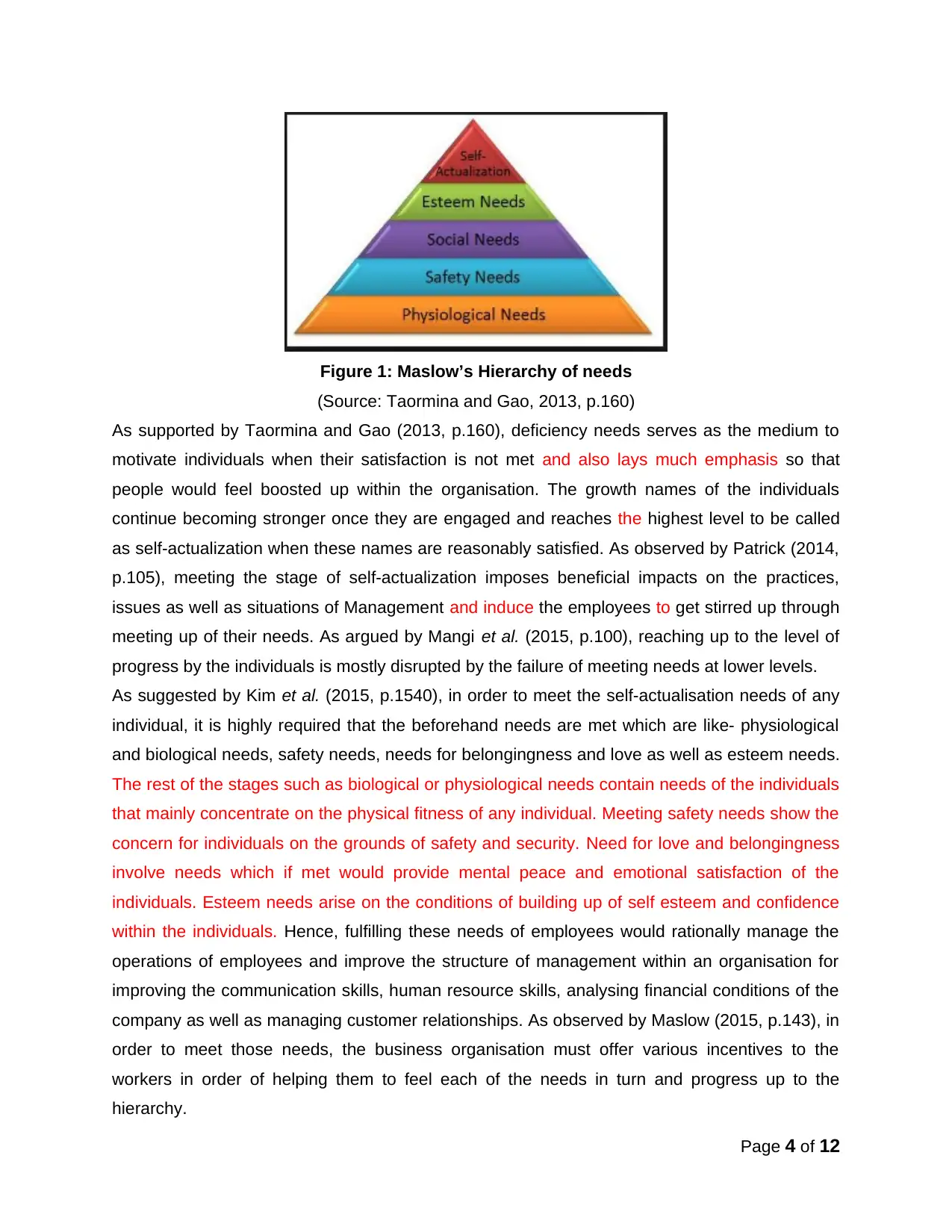
Figure 1: Maslow’s Hierarchy of needs
(Source: Taormina and Gao, 2013, p.160)
As supported by Taormina and Gao (2013, p.160), deficiency needs serves as the medium to
motivate individuals when their satisfaction is not met and also lays much emphasis so that
people would feel boosted up within the organisation. The growth names of the individuals
continue becoming stronger once they are engaged and reaches the highest level to be called
as self-actualization when these names are reasonably satisfied. As observed by Patrick (2014,
p.105), meeting the stage of self-actualization imposes beneficial impacts on the practices,
issues as well as situations of Management and induce the employees to get stirred up through
meeting up of their needs. As argued by Mangi et al. (2015, p.100), reaching up to the level of
progress by the individuals is mostly disrupted by the failure of meeting needs at lower levels.
As suggested by Kim et al. (2015, p.1540), in order to meet the self-actualisation needs of any
individual, it is highly required that the beforehand needs are met which are like- physiological
and biological needs, safety needs, needs for belongingness and love as well as esteem needs.
The rest of the stages such as biological or physiological needs contain needs of the individuals
that mainly concentrate on the physical fitness of any individual. Meeting safety needs show the
concern for individuals on the grounds of safety and security. Need for love and belongingness
involve needs which if met would provide mental peace and emotional satisfaction of the
individuals. Esteem needs arise on the conditions of building up of self esteem and confidence
within the individuals. Hence, fulfilling these needs of employees would rationally manage the
operations of employees and improve the structure of management within an organisation for
improving the communication skills, human resource skills, analysing financial conditions of the
company as well as managing customer relationships. As observed by Maslow (2015, p.143), in
order to meet those needs, the business organisation must offer various incentives to the
workers in order of helping them to feel each of the needs in turn and progress up to the
hierarchy.
Page 4 of 12
(Source: Taormina and Gao, 2013, p.160)
As supported by Taormina and Gao (2013, p.160), deficiency needs serves as the medium to
motivate individuals when their satisfaction is not met and also lays much emphasis so that
people would feel boosted up within the organisation. The growth names of the individuals
continue becoming stronger once they are engaged and reaches the highest level to be called
as self-actualization when these names are reasonably satisfied. As observed by Patrick (2014,
p.105), meeting the stage of self-actualization imposes beneficial impacts on the practices,
issues as well as situations of Management and induce the employees to get stirred up through
meeting up of their needs. As argued by Mangi et al. (2015, p.100), reaching up to the level of
progress by the individuals is mostly disrupted by the failure of meeting needs at lower levels.
As suggested by Kim et al. (2015, p.1540), in order to meet the self-actualisation needs of any
individual, it is highly required that the beforehand needs are met which are like- physiological
and biological needs, safety needs, needs for belongingness and love as well as esteem needs.
The rest of the stages such as biological or physiological needs contain needs of the individuals
that mainly concentrate on the physical fitness of any individual. Meeting safety needs show the
concern for individuals on the grounds of safety and security. Need for love and belongingness
involve needs which if met would provide mental peace and emotional satisfaction of the
individuals. Esteem needs arise on the conditions of building up of self esteem and confidence
within the individuals. Hence, fulfilling these needs of employees would rationally manage the
operations of employees and improve the structure of management within an organisation for
improving the communication skills, human resource skills, analysing financial conditions of the
company as well as managing customer relationships. As observed by Maslow (2015, p.143), in
order to meet those needs, the business organisation must offer various incentives to the
workers in order of helping them to feel each of the needs in turn and progress up to the
hierarchy.
Page 4 of 12
Secure Best Marks with AI Grader
Need help grading? Try our AI Grader for instant feedback on your assignments.
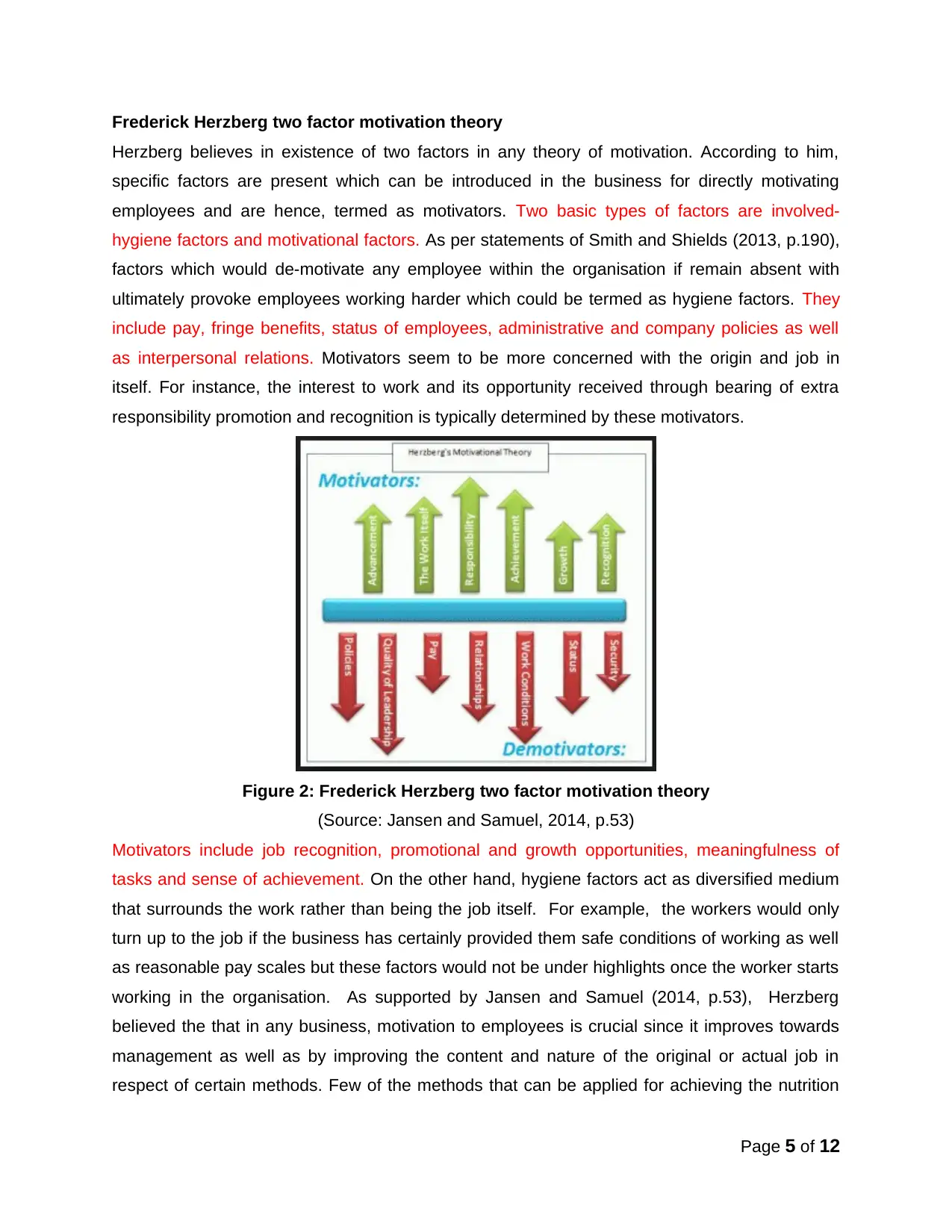
Frederick Herzberg two factor motivation theory
Herzberg believes in existence of two factors in any theory of motivation. According to him,
specific factors are present which can be introduced in the business for directly motivating
employees and are hence, termed as motivators. Two basic types of factors are involved-
hygiene factors and motivational factors. As per statements of Smith and Shields (2013, p.190),
factors which would de-motivate any employee within the organisation if remain absent with
ultimately provoke employees working harder which could be termed as hygiene factors. They
include pay, fringe benefits, status of employees, administrative and company policies as well
as interpersonal relations. Motivators seem to be more concerned with the origin and job in
itself. For instance, the interest to work and its opportunity received through bearing of extra
responsibility promotion and recognition is typically determined by these motivators.
Figure 2: Frederick Herzberg two factor motivation theory
(Source: Jansen and Samuel, 2014, p.53)
Motivators include job recognition, promotional and growth opportunities, meaningfulness of
tasks and sense of achievement. On the other hand, hygiene factors act as diversified medium
that surrounds the work rather than being the job itself. For example, the workers would only
turn up to the job if the business has certainly provided them safe conditions of working as well
as reasonable pay scales but these factors would not be under highlights once the worker starts
working in the organisation. As supported by Jansen and Samuel (2014, p.53), Herzberg
believed the that in any business, motivation to employees is crucial since it improves towards
management as well as by improving the content and nature of the original or actual job in
respect of certain methods. Few of the methods that can be applied for achieving the nutrition
Page 5 of 12
Herzberg believes in existence of two factors in any theory of motivation. According to him,
specific factors are present which can be introduced in the business for directly motivating
employees and are hence, termed as motivators. Two basic types of factors are involved-
hygiene factors and motivational factors. As per statements of Smith and Shields (2013, p.190),
factors which would de-motivate any employee within the organisation if remain absent with
ultimately provoke employees working harder which could be termed as hygiene factors. They
include pay, fringe benefits, status of employees, administrative and company policies as well
as interpersonal relations. Motivators seem to be more concerned with the origin and job in
itself. For instance, the interest to work and its opportunity received through bearing of extra
responsibility promotion and recognition is typically determined by these motivators.
Figure 2: Frederick Herzberg two factor motivation theory
(Source: Jansen and Samuel, 2014, p.53)
Motivators include job recognition, promotional and growth opportunities, meaningfulness of
tasks and sense of achievement. On the other hand, hygiene factors act as diversified medium
that surrounds the work rather than being the job itself. For example, the workers would only
turn up to the job if the business has certainly provided them safe conditions of working as well
as reasonable pay scales but these factors would not be under highlights once the worker starts
working in the organisation. As supported by Jansen and Samuel (2014, p.53), Herzberg
believed the that in any business, motivation to employees is crucial since it improves towards
management as well as by improving the content and nature of the original or actual job in
respect of certain methods. Few of the methods that can be applied for achieving the nutrition
Page 5 of 12
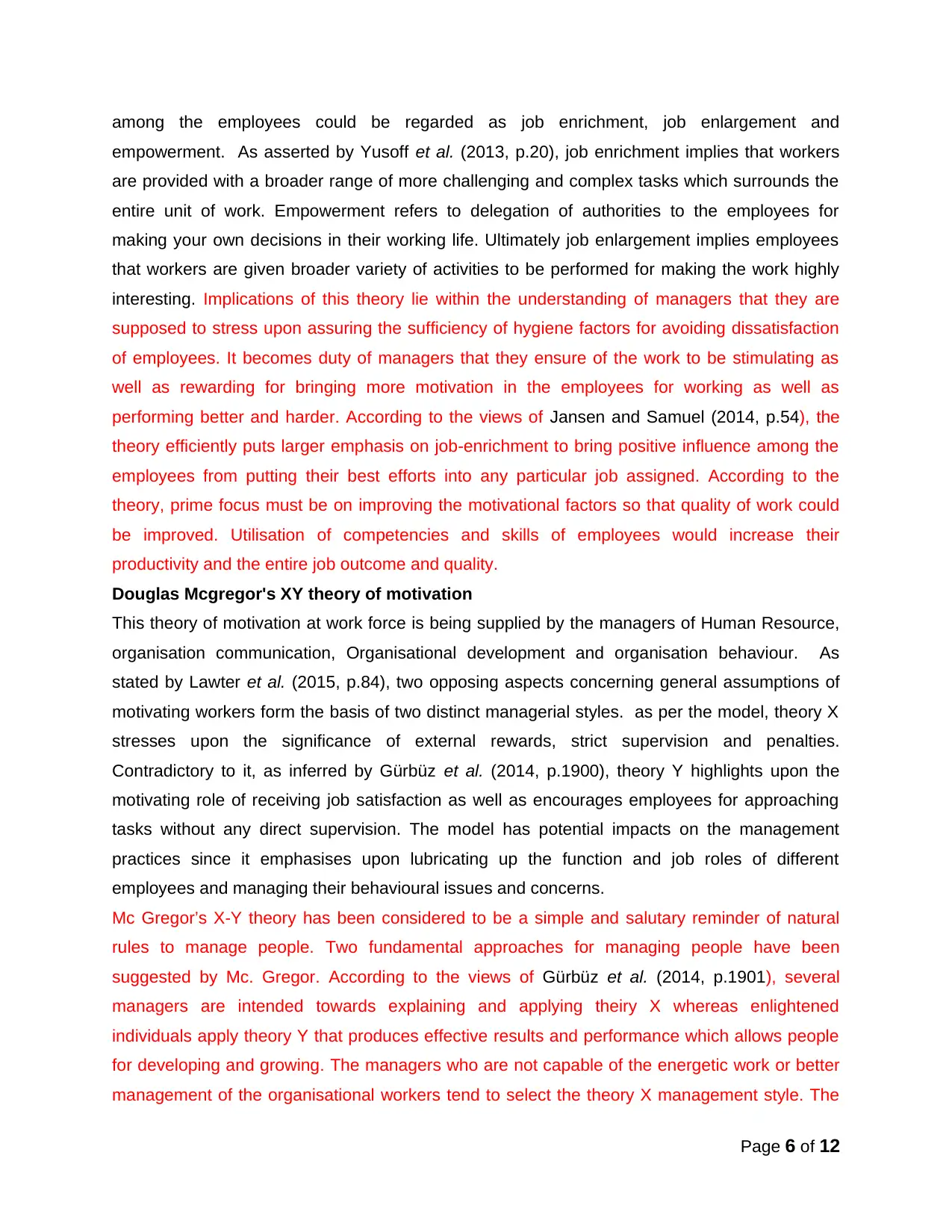
among the employees could be regarded as job enrichment, job enlargement and
empowerment. As asserted by Yusoff et al. (2013, p.20), job enrichment implies that workers
are provided with a broader range of more challenging and complex tasks which surrounds the
entire unit of work. Empowerment refers to delegation of authorities to the employees for
making your own decisions in their working life. Ultimately job enlargement implies employees
that workers are given broader variety of activities to be performed for making the work highly
interesting. Implications of this theory lie within the understanding of managers that they are
supposed to stress upon assuring the sufficiency of hygiene factors for avoiding dissatisfaction
of employees. It becomes duty of managers that they ensure of the work to be stimulating as
well as rewarding for bringing more motivation in the employees for working as well as
performing better and harder. According to the views of Jansen and Samuel (2014, p.54), the
theory efficiently puts larger emphasis on job-enrichment to bring positive influence among the
employees from putting their best efforts into any particular job assigned. According to the
theory, prime focus must be on improving the motivational factors so that quality of work could
be improved. Utilisation of competencies and skills of employees would increase their
productivity and the entire job outcome and quality.
Douglas Mcgregor's XY theory of motivation
This theory of motivation at work force is being supplied by the managers of Human Resource,
organisation communication, Organisational development and organisation behaviour. As
stated by Lawter et al. (2015, p.84), two opposing aspects concerning general assumptions of
motivating workers form the basis of two distinct managerial styles. as per the model, theory X
stresses upon the significance of external rewards, strict supervision and penalties.
Contradictory to it, as inferred by Gürbüz et al. (2014, p.1900), theory Y highlights upon the
motivating role of receiving job satisfaction as well as encourages employees for approaching
tasks without any direct supervision. The model has potential impacts on the management
practices since it emphasises upon lubricating up the function and job roles of different
employees and managing their behavioural issues and concerns.
Mc Gregor’s X-Y theory has been considered to be a simple and salutary reminder of natural
rules to manage people. Two fundamental approaches for managing people have been
suggested by Mc. Gregor. According to the views of Gürbüz et al. (2014, p.1901), several
managers are intended towards explaining and applying theiry X whereas enlightened
individuals apply theory Y that produces effective results and performance which allows people
for developing and growing. The managers who are not capable of the energetic work or better
management of the organisational workers tend to select the theory X management style. The
Page 6 of 12
empowerment. As asserted by Yusoff et al. (2013, p.20), job enrichment implies that workers
are provided with a broader range of more challenging and complex tasks which surrounds the
entire unit of work. Empowerment refers to delegation of authorities to the employees for
making your own decisions in their working life. Ultimately job enlargement implies employees
that workers are given broader variety of activities to be performed for making the work highly
interesting. Implications of this theory lie within the understanding of managers that they are
supposed to stress upon assuring the sufficiency of hygiene factors for avoiding dissatisfaction
of employees. It becomes duty of managers that they ensure of the work to be stimulating as
well as rewarding for bringing more motivation in the employees for working as well as
performing better and harder. According to the views of Jansen and Samuel (2014, p.54), the
theory efficiently puts larger emphasis on job-enrichment to bring positive influence among the
employees from putting their best efforts into any particular job assigned. According to the
theory, prime focus must be on improving the motivational factors so that quality of work could
be improved. Utilisation of competencies and skills of employees would increase their
productivity and the entire job outcome and quality.
Douglas Mcgregor's XY theory of motivation
This theory of motivation at work force is being supplied by the managers of Human Resource,
organisation communication, Organisational development and organisation behaviour. As
stated by Lawter et al. (2015, p.84), two opposing aspects concerning general assumptions of
motivating workers form the basis of two distinct managerial styles. as per the model, theory X
stresses upon the significance of external rewards, strict supervision and penalties.
Contradictory to it, as inferred by Gürbüz et al. (2014, p.1900), theory Y highlights upon the
motivating role of receiving job satisfaction as well as encourages employees for approaching
tasks without any direct supervision. The model has potential impacts on the management
practices since it emphasises upon lubricating up the function and job roles of different
employees and managing their behavioural issues and concerns.
Mc Gregor’s X-Y theory has been considered to be a simple and salutary reminder of natural
rules to manage people. Two fundamental approaches for managing people have been
suggested by Mc. Gregor. According to the views of Gürbüz et al. (2014, p.1901), several
managers are intended towards explaining and applying theiry X whereas enlightened
individuals apply theory Y that produces effective results and performance which allows people
for developing and growing. The managers who are not capable of the energetic work or better
management of the organisational workers tend to select the theory X management style. The
Page 6 of 12
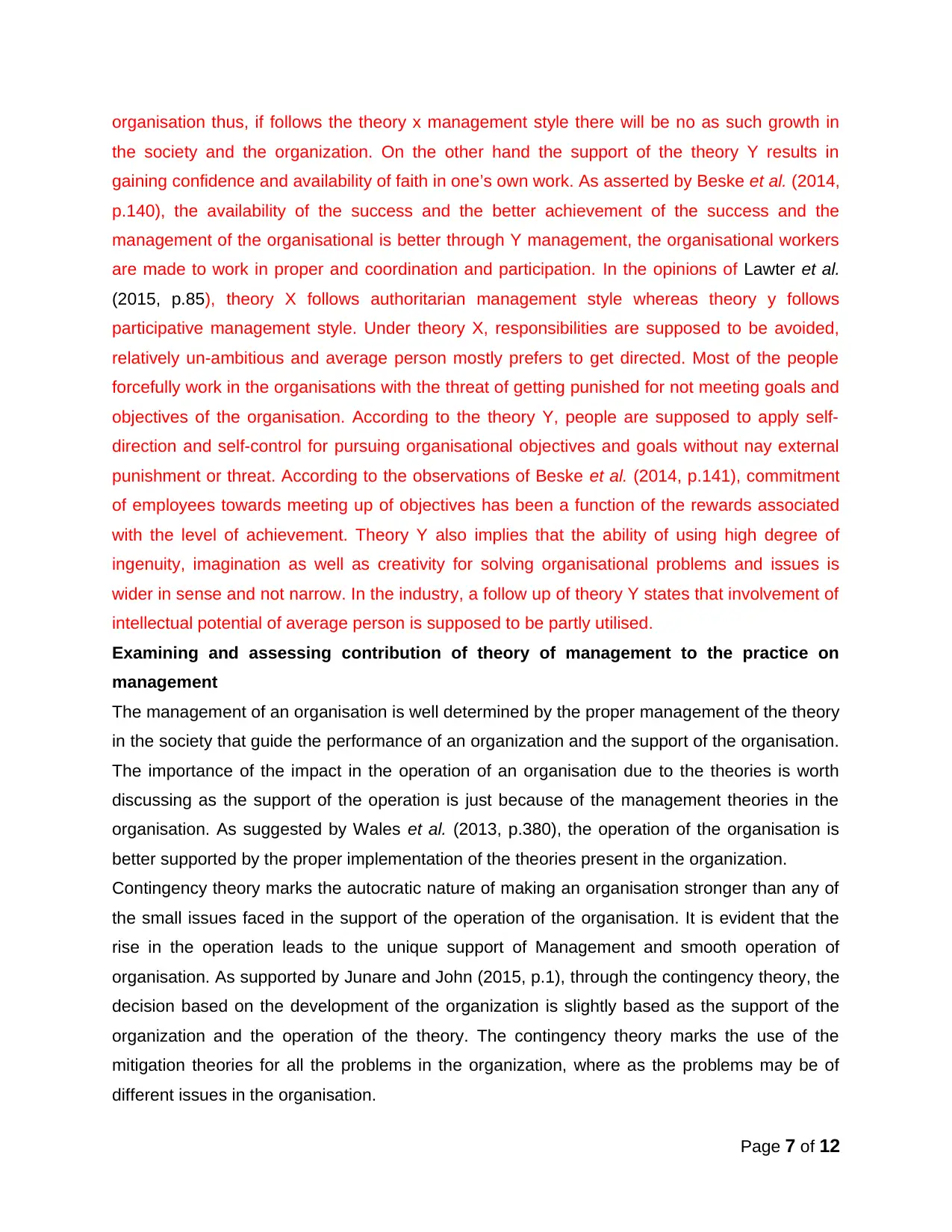
organisation thus, if follows the theory x management style there will be no as such growth in
the society and the organization. On the other hand the support of the theory Y results in
gaining confidence and availability of faith in one’s own work. As asserted by Beske et al. (2014,
p.140), the availability of the success and the better achievement of the success and the
management of the organisational is better through Y management, the organisational workers
are made to work in proper and coordination and participation. In the opinions of Lawter et al.
(2015, p.85), theory X follows authoritarian management style whereas theory y follows
participative management style. Under theory X, responsibilities are supposed to be avoided,
relatively un-ambitious and average person mostly prefers to get directed. Most of the people
forcefully work in the organisations with the threat of getting punished for not meeting goals and
objectives of the organisation. According to the theory Y, people are supposed to apply self-
direction and self-control for pursuing organisational objectives and goals without nay external
punishment or threat. According to the observations of Beske et al. (2014, p.141), commitment
of employees towards meeting up of objectives has been a function of the rewards associated
with the level of achievement. Theory Y also implies that the ability of using high degree of
ingenuity, imagination as well as creativity for solving organisational problems and issues is
wider in sense and not narrow. In the industry, a follow up of theory Y states that involvement of
intellectual potential of average person is supposed to be partly utilised.
Examining and assessing contribution of theory of management to the practice on
management
The management of an organisation is well determined by the proper management of the theory
in the society that guide the performance of an organization and the support of the organisation.
The importance of the impact in the operation of an organisation due to the theories is worth
discussing as the support of the operation is just because of the management theories in the
organisation. As suggested by Wales et al. (2013, p.380), the operation of the organisation is
better supported by the proper implementation of the theories present in the organization.
Contingency theory marks the autocratic nature of making an organisation stronger than any of
the small issues faced in the support of the operation of the organisation. It is evident that the
rise in the operation leads to the unique support of Management and smooth operation of
organisation. As supported by Junare and John (2015, p.1), through the contingency theory, the
decision based on the development of the organization is slightly based as the support of the
organization and the operation of the theory. The contingency theory marks the use of the
mitigation theories for all the problems in the organization, where as the problems may be of
different issues in the organisation.
Page 7 of 12
the society and the organization. On the other hand the support of the theory Y results in
gaining confidence and availability of faith in one’s own work. As asserted by Beske et al. (2014,
p.140), the availability of the success and the better achievement of the success and the
management of the organisational is better through Y management, the organisational workers
are made to work in proper and coordination and participation. In the opinions of Lawter et al.
(2015, p.85), theory X follows authoritarian management style whereas theory y follows
participative management style. Under theory X, responsibilities are supposed to be avoided,
relatively un-ambitious and average person mostly prefers to get directed. Most of the people
forcefully work in the organisations with the threat of getting punished for not meeting goals and
objectives of the organisation. According to the theory Y, people are supposed to apply self-
direction and self-control for pursuing organisational objectives and goals without nay external
punishment or threat. According to the observations of Beske et al. (2014, p.141), commitment
of employees towards meeting up of objectives has been a function of the rewards associated
with the level of achievement. Theory Y also implies that the ability of using high degree of
ingenuity, imagination as well as creativity for solving organisational problems and issues is
wider in sense and not narrow. In the industry, a follow up of theory Y states that involvement of
intellectual potential of average person is supposed to be partly utilised.
Examining and assessing contribution of theory of management to the practice on
management
The management of an organisation is well determined by the proper management of the theory
in the society that guide the performance of an organization and the support of the organisation.
The importance of the impact in the operation of an organisation due to the theories is worth
discussing as the support of the operation is just because of the management theories in the
organisation. As suggested by Wales et al. (2013, p.380), the operation of the organisation is
better supported by the proper implementation of the theories present in the organization.
Contingency theory marks the autocratic nature of making an organisation stronger than any of
the small issues faced in the support of the operation of the organisation. It is evident that the
rise in the operation leads to the unique support of Management and smooth operation of
organisation. As supported by Junare and John (2015, p.1), through the contingency theory, the
decision based on the development of the organization is slightly based as the support of the
organization and the operation of the theory. The contingency theory marks the use of the
mitigation theories for all the problems in the organization, where as the problems may be of
different issues in the organisation.
Page 7 of 12
Paraphrase This Document
Need a fresh take? Get an instant paraphrase of this document with our AI Paraphraser
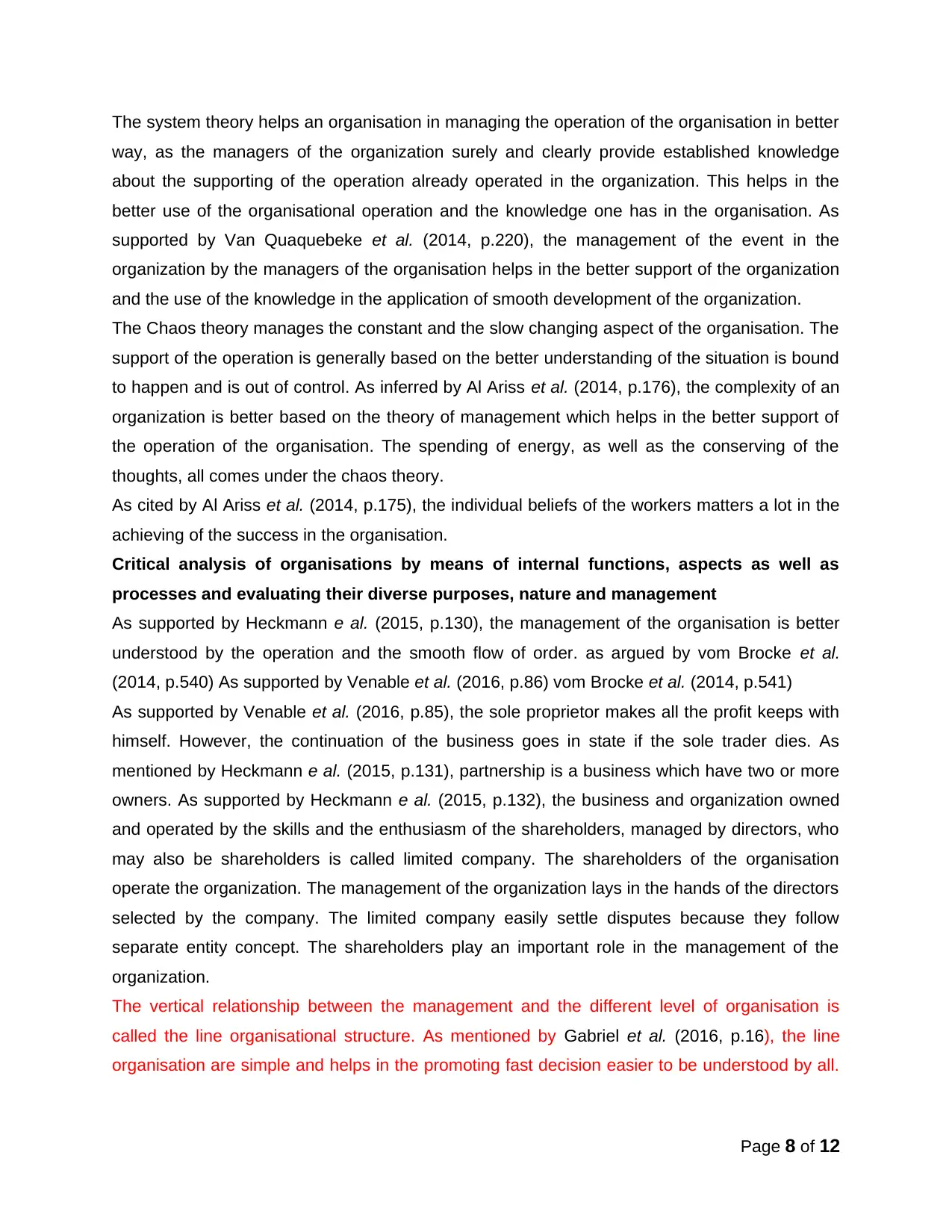
The system theory helps an organisation in managing the operation of the organisation in better
way, as the managers of the organization surely and clearly provide established knowledge
about the supporting of the operation already operated in the organization. This helps in the
better use of the organisational operation and the knowledge one has in the organisation. As
supported by Van Quaquebeke et al. (2014, p.220), the management of the event in the
organization by the managers of the organisation helps in the better support of the organization
and the use of the knowledge in the application of smooth development of the organization.
The Chaos theory manages the constant and the slow changing aspect of the organisation. The
support of the operation is generally based on the better understanding of the situation is bound
to happen and is out of control. As inferred by Al Ariss et al. (2014, p.176), the complexity of an
organization is better based on the theory of management which helps in the better support of
the operation of the organisation. The spending of energy, as well as the conserving of the
thoughts, all comes under the chaos theory.
As cited by Al Ariss et al. (2014, p.175), the individual beliefs of the workers matters a lot in the
achieving of the success in the organisation.
Critical analysis of organisations by means of internal functions, aspects as well as
processes and evaluating their diverse purposes, nature and management
As supported by Heckmann e al. (2015, p.130), the management of the organisation is better
understood by the operation and the smooth flow of order. as argued by vom Brocke et al.
(2014, p.540) As supported by Venable et al. (2016, p.86) vom Brocke et al. (2014, p.541)
As supported by Venable et al. (2016, p.85), the sole proprietor makes all the profit keeps with
himself. However, the continuation of the business goes in state if the sole trader dies. As
mentioned by Heckmann e al. (2015, p.131), partnership is a business which have two or more
owners. As supported by Heckmann e al. (2015, p.132), the business and organization owned
and operated by the skills and the enthusiasm of the shareholders, managed by directors, who
may also be shareholders is called limited company. The shareholders of the organisation
operate the organization. The management of the organization lays in the hands of the directors
selected by the company. The limited company easily settle disputes because they follow
separate entity concept. The shareholders play an important role in the management of the
organization.
The vertical relationship between the management and the different level of organisation is
called the line organisational structure. As mentioned by Gabriel et al. (2016, p.16), the line
organisation are simple and helps in the promoting fast decision easier to be understood by all.
Page 8 of 12
way, as the managers of the organization surely and clearly provide established knowledge
about the supporting of the operation already operated in the organization. This helps in the
better use of the organisational operation and the knowledge one has in the organisation. As
supported by Van Quaquebeke et al. (2014, p.220), the management of the event in the
organization by the managers of the organisation helps in the better support of the organization
and the use of the knowledge in the application of smooth development of the organization.
The Chaos theory manages the constant and the slow changing aspect of the organisation. The
support of the operation is generally based on the better understanding of the situation is bound
to happen and is out of control. As inferred by Al Ariss et al. (2014, p.176), the complexity of an
organization is better based on the theory of management which helps in the better support of
the operation of the organisation. The spending of energy, as well as the conserving of the
thoughts, all comes under the chaos theory.
As cited by Al Ariss et al. (2014, p.175), the individual beliefs of the workers matters a lot in the
achieving of the success in the organisation.
Critical analysis of organisations by means of internal functions, aspects as well as
processes and evaluating their diverse purposes, nature and management
As supported by Heckmann e al. (2015, p.130), the management of the organisation is better
understood by the operation and the smooth flow of order. as argued by vom Brocke et al.
(2014, p.540) As supported by Venable et al. (2016, p.86) vom Brocke et al. (2014, p.541)
As supported by Venable et al. (2016, p.85), the sole proprietor makes all the profit keeps with
himself. However, the continuation of the business goes in state if the sole trader dies. As
mentioned by Heckmann e al. (2015, p.131), partnership is a business which have two or more
owners. As supported by Heckmann e al. (2015, p.132), the business and organization owned
and operated by the skills and the enthusiasm of the shareholders, managed by directors, who
may also be shareholders is called limited company. The shareholders of the organisation
operate the organization. The management of the organization lays in the hands of the directors
selected by the company. The limited company easily settle disputes because they follow
separate entity concept. The shareholders play an important role in the management of the
organization.
The vertical relationship between the management and the different level of organisation is
called the line organisational structure. As mentioned by Gabriel et al. (2016, p.16), the line
organisation are simple and helps in the promoting fast decision easier to be understood by all.
Page 8 of 12
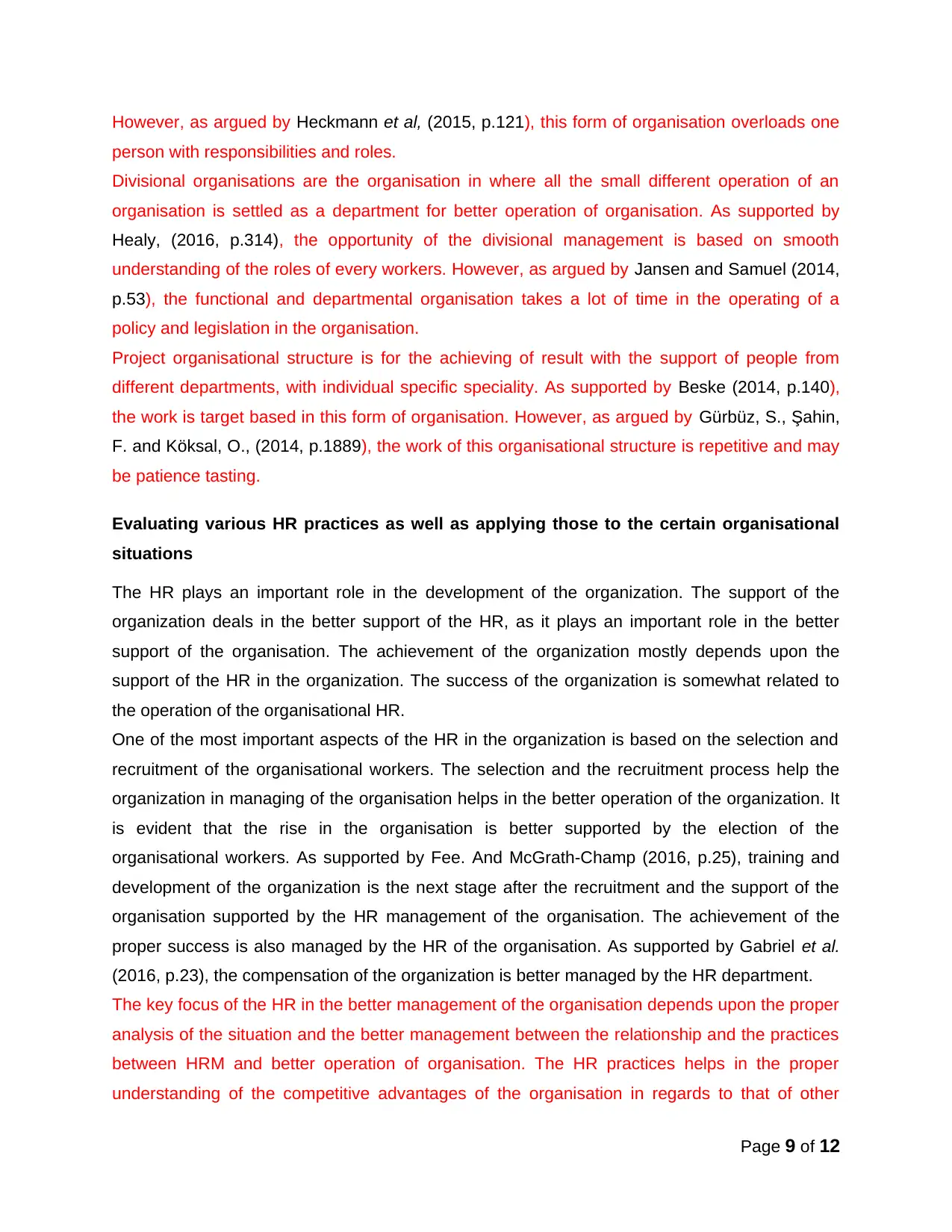
However, as argued by Heckmann et al, (2015, p.121), this form of organisation overloads one
person with responsibilities and roles.
Divisional organisations are the organisation in where all the small different operation of an
organisation is settled as a department for better operation of organisation. As supported by
Healy, (2016, p.314), the opportunity of the divisional management is based on smooth
understanding of the roles of every workers. However, as argued by Jansen and Samuel (2014,
p.53), the functional and departmental organisation takes a lot of time in the operating of a
policy and legislation in the organisation.
Project organisational structure is for the achieving of result with the support of people from
different departments, with individual specific speciality. As supported by Beske (2014, p.140),
the work is target based in this form of organisation. However, as argued by Gürbüz, S., Şahin,
F. and Köksal, O., (2014, p.1889), the work of this organisational structure is repetitive and may
be patience tasting.
Evaluating various HR practices as well as applying those to the certain organisational
situations
The HR plays an important role in the development of the organization. The support of the
organization deals in the better support of the HR, as it plays an important role in the better
support of the organisation. The achievement of the organization mostly depends upon the
support of the HR in the organization. The success of the organization is somewhat related to
the operation of the organisational HR.
One of the most important aspects of the HR in the organization is based on the selection and
recruitment of the organisational workers. The selection and the recruitment process help the
organization in managing of the organisation helps in the better operation of the organization. It
is evident that the rise in the organisation is better supported by the election of the
organisational workers. As supported by Fee. And McGrath-Champ (2016, p.25), training and
development of the organization is the next stage after the recruitment and the support of the
organisation supported by the HR management of the organisation. The achievement of the
proper success is also managed by the HR of the organisation. As supported by Gabriel et al.
(2016, p.23), the compensation of the organization is better managed by the HR department.
The key focus of the HR in the better management of the organisation depends upon the proper
analysis of the situation and the better management between the relationship and the practices
between HRM and better operation of organisation. The HR practices helps in the proper
understanding of the competitive advantages of the organisation in regards to that of other
Page 9 of 12
person with responsibilities and roles.
Divisional organisations are the organisation in where all the small different operation of an
organisation is settled as a department for better operation of organisation. As supported by
Healy, (2016, p.314), the opportunity of the divisional management is based on smooth
understanding of the roles of every workers. However, as argued by Jansen and Samuel (2014,
p.53), the functional and departmental organisation takes a lot of time in the operating of a
policy and legislation in the organisation.
Project organisational structure is for the achieving of result with the support of people from
different departments, with individual specific speciality. As supported by Beske (2014, p.140),
the work is target based in this form of organisation. However, as argued by Gürbüz, S., Şahin,
F. and Köksal, O., (2014, p.1889), the work of this organisational structure is repetitive and may
be patience tasting.
Evaluating various HR practices as well as applying those to the certain organisational
situations
The HR plays an important role in the development of the organization. The support of the
organization deals in the better support of the HR, as it plays an important role in the better
support of the organisation. The achievement of the organization mostly depends upon the
support of the HR in the organization. The success of the organization is somewhat related to
the operation of the organisational HR.
One of the most important aspects of the HR in the organization is based on the selection and
recruitment of the organisational workers. The selection and the recruitment process help the
organization in managing of the organisation helps in the better operation of the organization. It
is evident that the rise in the organisation is better supported by the election of the
organisational workers. As supported by Fee. And McGrath-Champ (2016, p.25), training and
development of the organization is the next stage after the recruitment and the support of the
organisation supported by the HR management of the organisation. The achievement of the
proper success is also managed by the HR of the organisation. As supported by Gabriel et al.
(2016, p.23), the compensation of the organization is better managed by the HR department.
The key focus of the HR in the better management of the organisation depends upon the proper
analysis of the situation and the better management between the relationship and the practices
between HRM and better operation of organisation. The HR practices helps in the proper
understanding of the competitive advantages of the organisation in regards to that of other
Page 9 of 12
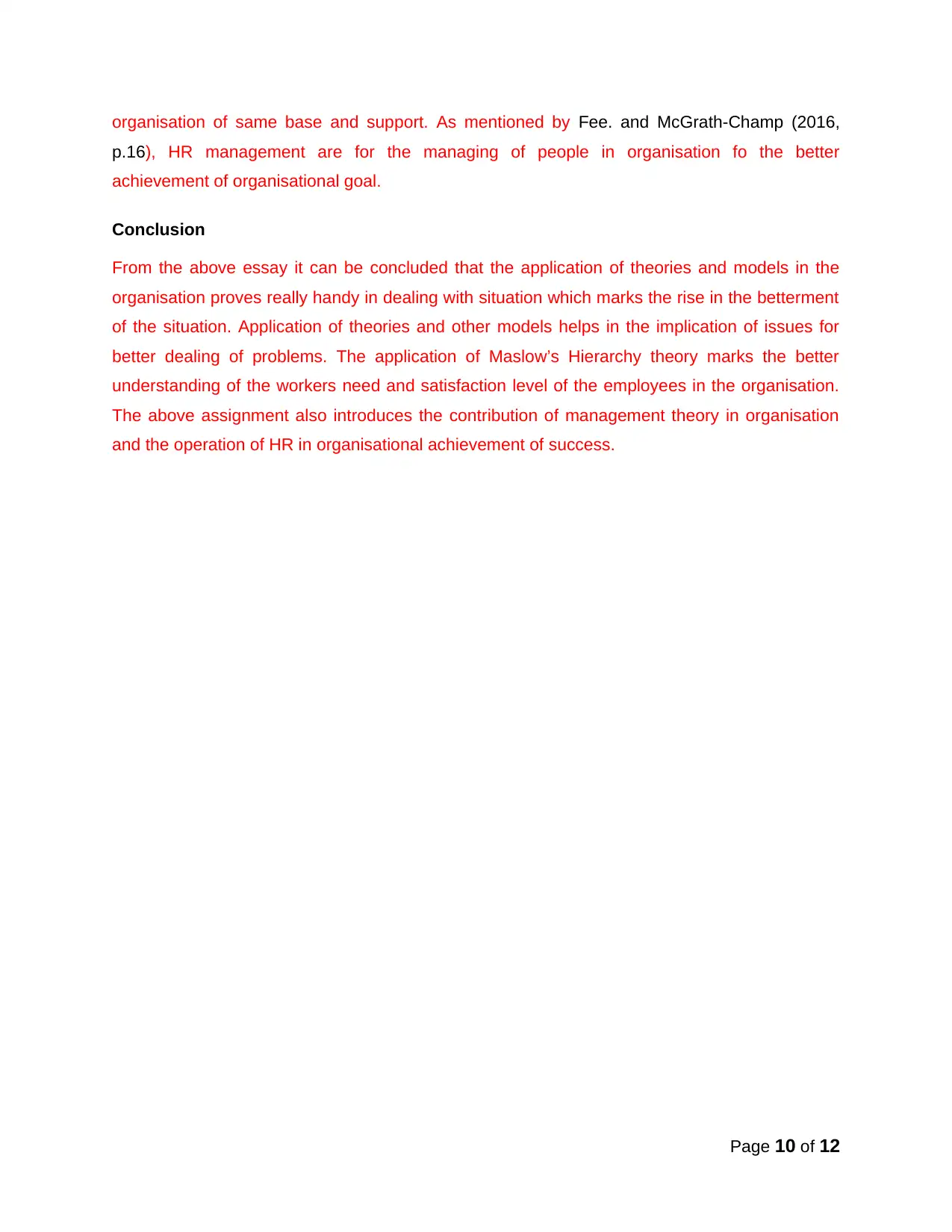
organisation of same base and support. As mentioned by Fee. and McGrath-Champ (2016,
p.16), HR management are for the managing of people in organisation fo the better
achievement of organisational goal.
Conclusion
From the above essay it can be concluded that the application of theories and models in the
organisation proves really handy in dealing with situation which marks the rise in the betterment
of the situation. Application of theories and other models helps in the implication of issues for
better dealing of problems. The application of Maslow’s Hierarchy theory marks the better
understanding of the workers need and satisfaction level of the employees in the organisation.
The above assignment also introduces the contribution of management theory in organisation
and the operation of HR in organisational achievement of success.
Page 10 of 12
p.16), HR management are for the managing of people in organisation fo the better
achievement of organisational goal.
Conclusion
From the above essay it can be concluded that the application of theories and models in the
organisation proves really handy in dealing with situation which marks the rise in the betterment
of the situation. Application of theories and other models helps in the implication of issues for
better dealing of problems. The application of Maslow’s Hierarchy theory marks the better
understanding of the workers need and satisfaction level of the employees in the organisation.
The above assignment also introduces the contribution of management theory in organisation
and the operation of HR in organisational achievement of success.
Page 10 of 12
Secure Best Marks with AI Grader
Need help grading? Try our AI Grader for instant feedback on your assignments.
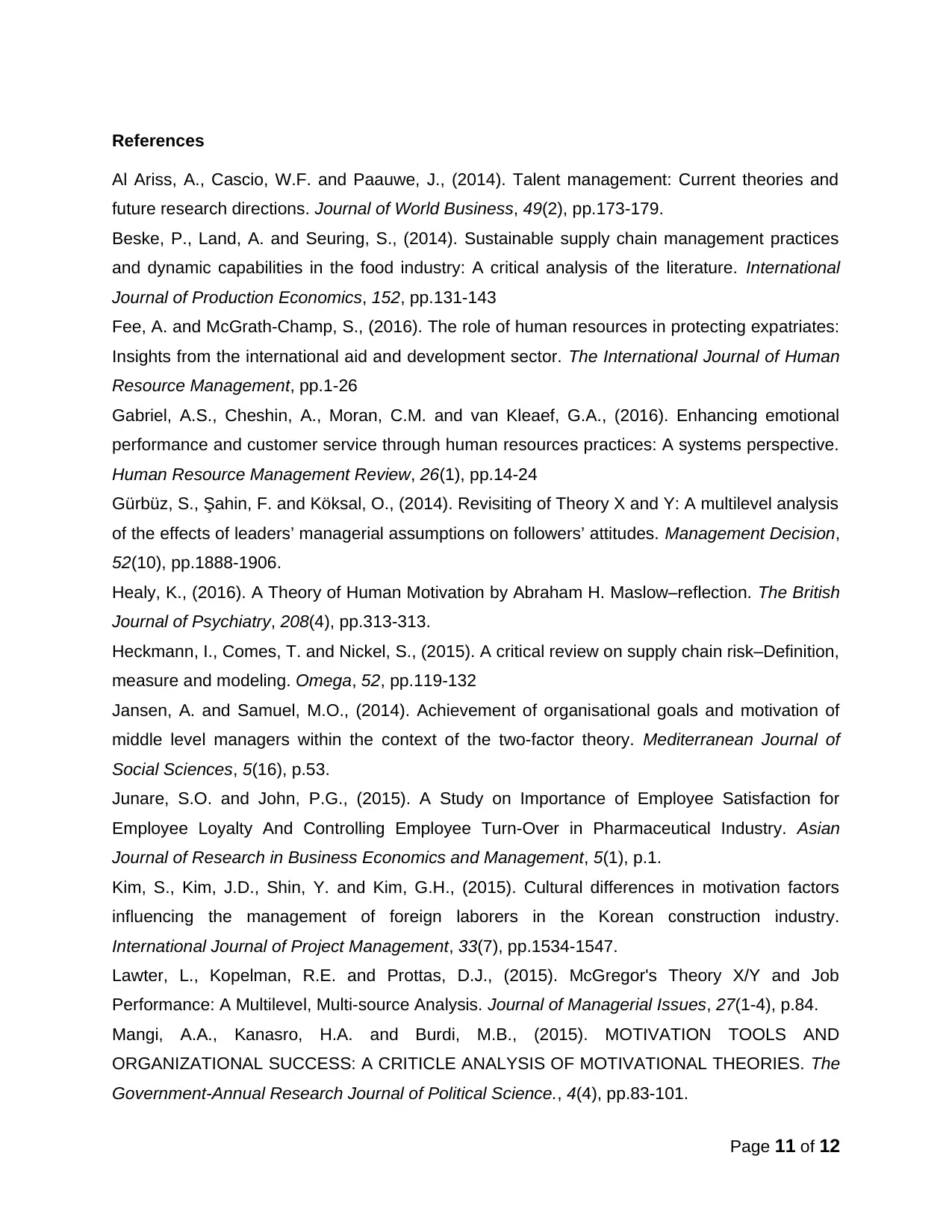
References
Al Ariss, A., Cascio, W.F. and Paauwe, J., (2014). Talent management: Current theories and
future research directions. Journal of World Business, 49(2), pp.173-179.
Beske, P., Land, A. and Seuring, S., (2014). Sustainable supply chain management practices
and dynamic capabilities in the food industry: A critical analysis of the literature. International
Journal of Production Economics, 152, pp.131-143
Fee, A. and McGrath-Champ, S., (2016). The role of human resources in protecting expatriates:
Insights from the international aid and development sector. The International Journal of Human
Resource Management, pp.1-26
Gabriel, A.S., Cheshin, A., Moran, C.M. and van Kleaef, G.A., (2016). Enhancing emotional
performance and customer service through human resources practices: A systems perspective.
Human Resource Management Review, 26(1), pp.14-24
Gürbüz, S., Şahin, F. and Köksal, O., (2014). Revisiting of Theory X and Y: A multilevel analysis
of the effects of leaders’ managerial assumptions on followers’ attitudes. Management Decision,
52(10), pp.1888-1906.
Healy, K., (2016). A Theory of Human Motivation by Abraham H. Maslow–reflection. The British
Journal of Psychiatry, 208(4), pp.313-313.
Heckmann, I., Comes, T. and Nickel, S., (2015). A critical review on supply chain risk–Definition,
measure and modeling. Omega, 52, pp.119-132
Jansen, A. and Samuel, M.O., (2014). Achievement of organisational goals and motivation of
middle level managers within the context of the two-factor theory. Mediterranean Journal of
Social Sciences, 5(16), p.53.
Junare, S.O. and John, P.G., (2015). A Study on Importance of Employee Satisfaction for
Employee Loyalty And Controlling Employee Turn-Over in Pharmaceutical Industry. Asian
Journal of Research in Business Economics and Management, 5(1), p.1.
Kim, S., Kim, J.D., Shin, Y. and Kim, G.H., (2015). Cultural differences in motivation factors
influencing the management of foreign laborers in the Korean construction industry.
International Journal of Project Management, 33(7), pp.1534-1547.
Lawter, L., Kopelman, R.E. and Prottas, D.J., (2015). McGregor's Theory X/Y and Job
Performance: A Multilevel, Multi-source Analysis. Journal of Managerial Issues, 27(1-4), p.84.
Mangi, A.A., Kanasro, H.A. and Burdi, M.B., (2015). MOTIVATION TOOLS AND
ORGANIZATIONAL SUCCESS: A CRITICLE ANALYSIS OF MOTIVATIONAL THEORIES. The
Government-Annual Research Journal of Political Science., 4(4), pp.83-101.
Page 11 of 12
Al Ariss, A., Cascio, W.F. and Paauwe, J., (2014). Talent management: Current theories and
future research directions. Journal of World Business, 49(2), pp.173-179.
Beske, P., Land, A. and Seuring, S., (2014). Sustainable supply chain management practices
and dynamic capabilities in the food industry: A critical analysis of the literature. International
Journal of Production Economics, 152, pp.131-143
Fee, A. and McGrath-Champ, S., (2016). The role of human resources in protecting expatriates:
Insights from the international aid and development sector. The International Journal of Human
Resource Management, pp.1-26
Gabriel, A.S., Cheshin, A., Moran, C.M. and van Kleaef, G.A., (2016). Enhancing emotional
performance and customer service through human resources practices: A systems perspective.
Human Resource Management Review, 26(1), pp.14-24
Gürbüz, S., Şahin, F. and Köksal, O., (2014). Revisiting of Theory X and Y: A multilevel analysis
of the effects of leaders’ managerial assumptions on followers’ attitudes. Management Decision,
52(10), pp.1888-1906.
Healy, K., (2016). A Theory of Human Motivation by Abraham H. Maslow–reflection. The British
Journal of Psychiatry, 208(4), pp.313-313.
Heckmann, I., Comes, T. and Nickel, S., (2015). A critical review on supply chain risk–Definition,
measure and modeling. Omega, 52, pp.119-132
Jansen, A. and Samuel, M.O., (2014). Achievement of organisational goals and motivation of
middle level managers within the context of the two-factor theory. Mediterranean Journal of
Social Sciences, 5(16), p.53.
Junare, S.O. and John, P.G., (2015). A Study on Importance of Employee Satisfaction for
Employee Loyalty And Controlling Employee Turn-Over in Pharmaceutical Industry. Asian
Journal of Research in Business Economics and Management, 5(1), p.1.
Kim, S., Kim, J.D., Shin, Y. and Kim, G.H., (2015). Cultural differences in motivation factors
influencing the management of foreign laborers in the Korean construction industry.
International Journal of Project Management, 33(7), pp.1534-1547.
Lawter, L., Kopelman, R.E. and Prottas, D.J., (2015). McGregor's Theory X/Y and Job
Performance: A Multilevel, Multi-source Analysis. Journal of Managerial Issues, 27(1-4), p.84.
Mangi, A.A., Kanasro, H.A. and Burdi, M.B., (2015). MOTIVATION TOOLS AND
ORGANIZATIONAL SUCCESS: A CRITICLE ANALYSIS OF MOTIVATIONAL THEORIES. The
Government-Annual Research Journal of Political Science., 4(4), pp.83-101.
Page 11 of 12
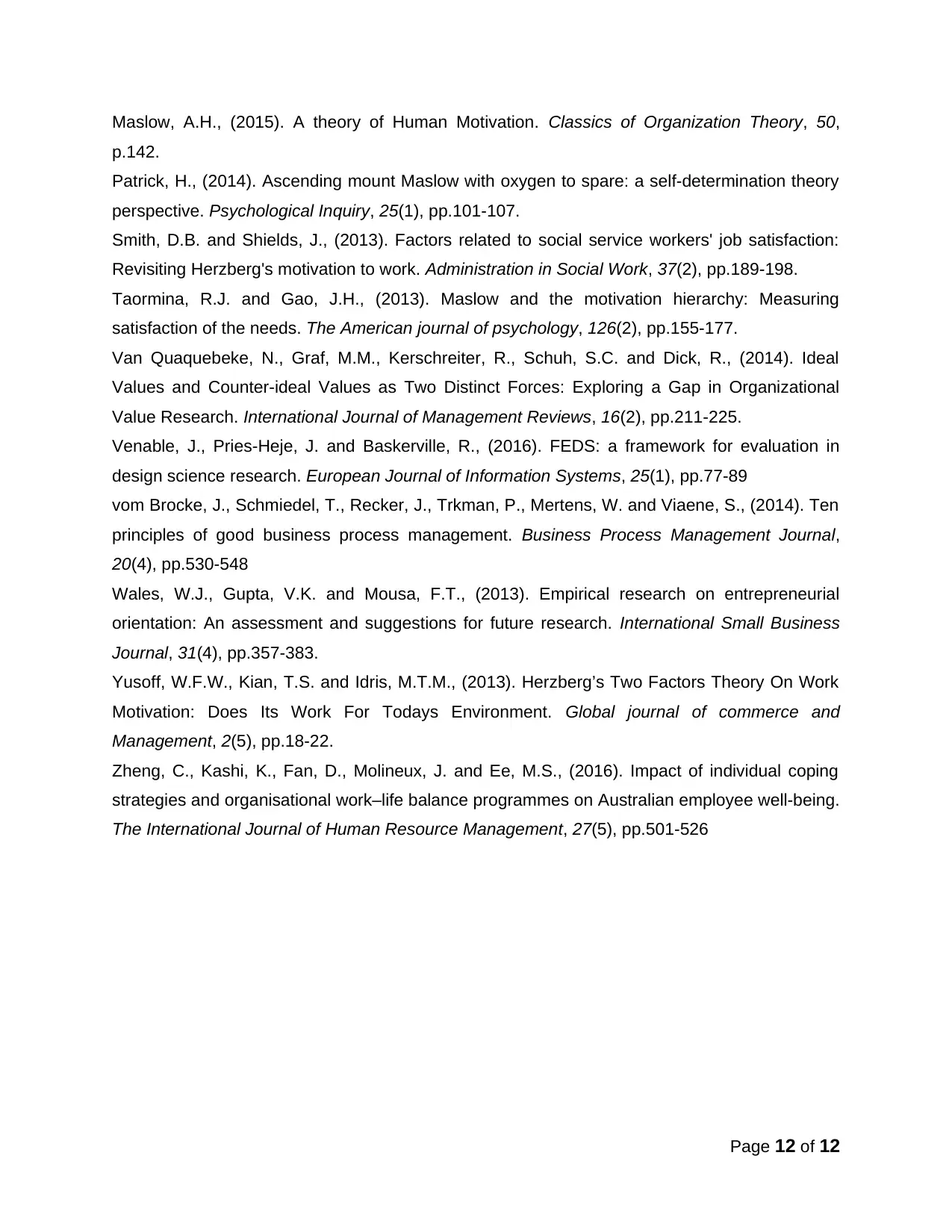
Maslow, A.H., (2015). A theory of Human Motivation. Classics of Organization Theory, 50,
p.142.
Patrick, H., (2014). Ascending mount Maslow with oxygen to spare: a self-determination theory
perspective. Psychological Inquiry, 25(1), pp.101-107.
Smith, D.B. and Shields, J., (2013). Factors related to social service workers' job satisfaction:
Revisiting Herzberg's motivation to work. Administration in Social Work, 37(2), pp.189-198.
Taormina, R.J. and Gao, J.H., (2013). Maslow and the motivation hierarchy: Measuring
satisfaction of the needs. The American journal of psychology, 126(2), pp.155-177.
Van Quaquebeke, N., Graf, M.M., Kerschreiter, R., Schuh, S.C. and Dick, R., (2014). Ideal
Values and Counter‐ideal Values as Two Distinct Forces: Exploring a Gap in Organizational
Value Research. International Journal of Management Reviews, 16(2), pp.211-225.
Venable, J., Pries-Heje, J. and Baskerville, R., (2016). FEDS: a framework for evaluation in
design science research. European Journal of Information Systems, 25(1), pp.77-89
vom Brocke, J., Schmiedel, T., Recker, J., Trkman, P., Mertens, W. and Viaene, S., (2014). Ten
principles of good business process management. Business Process Management Journal,
20(4), pp.530-548
Wales, W.J., Gupta, V.K. and Mousa, F.T., (2013). Empirical research on entrepreneurial
orientation: An assessment and suggestions for future research. International Small Business
Journal, 31(4), pp.357-383.
Yusoff, W.F.W., Kian, T.S. and Idris, M.T.M., (2013). Herzberg’s Two Factors Theory On Work
Motivation: Does Its Work For Todays Environment. Global journal of commerce and
Management, 2(5), pp.18-22.
Zheng, C., Kashi, K., Fan, D., Molineux, J. and Ee, M.S., (2016). Impact of individual coping
strategies and organisational work–life balance programmes on Australian employee well-being.
The International Journal of Human Resource Management, 27(5), pp.501-526
Page 12 of 12
p.142.
Patrick, H., (2014). Ascending mount Maslow with oxygen to spare: a self-determination theory
perspective. Psychological Inquiry, 25(1), pp.101-107.
Smith, D.B. and Shields, J., (2013). Factors related to social service workers' job satisfaction:
Revisiting Herzberg's motivation to work. Administration in Social Work, 37(2), pp.189-198.
Taormina, R.J. and Gao, J.H., (2013). Maslow and the motivation hierarchy: Measuring
satisfaction of the needs. The American journal of psychology, 126(2), pp.155-177.
Van Quaquebeke, N., Graf, M.M., Kerschreiter, R., Schuh, S.C. and Dick, R., (2014). Ideal
Values and Counter‐ideal Values as Two Distinct Forces: Exploring a Gap in Organizational
Value Research. International Journal of Management Reviews, 16(2), pp.211-225.
Venable, J., Pries-Heje, J. and Baskerville, R., (2016). FEDS: a framework for evaluation in
design science research. European Journal of Information Systems, 25(1), pp.77-89
vom Brocke, J., Schmiedel, T., Recker, J., Trkman, P., Mertens, W. and Viaene, S., (2014). Ten
principles of good business process management. Business Process Management Journal,
20(4), pp.530-548
Wales, W.J., Gupta, V.K. and Mousa, F.T., (2013). Empirical research on entrepreneurial
orientation: An assessment and suggestions for future research. International Small Business
Journal, 31(4), pp.357-383.
Yusoff, W.F.W., Kian, T.S. and Idris, M.T.M., (2013). Herzberg’s Two Factors Theory On Work
Motivation: Does Its Work For Todays Environment. Global journal of commerce and
Management, 2(5), pp.18-22.
Zheng, C., Kashi, K., Fan, D., Molineux, J. and Ee, M.S., (2016). Impact of individual coping
strategies and organisational work–life balance programmes on Australian employee well-being.
The International Journal of Human Resource Management, 27(5), pp.501-526
Page 12 of 12
1 out of 12
Related Documents
Your All-in-One AI-Powered Toolkit for Academic Success.
+13062052269
info@desklib.com
Available 24*7 on WhatsApp / Email
![[object Object]](/_next/static/media/star-bottom.7253800d.svg)
Unlock your academic potential
© 2024 | Zucol Services PVT LTD | All rights reserved.





